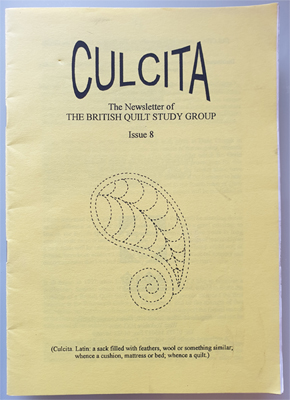The Paisley Collections
The Paisley Collections comprise a total of 65 cot-sized quilts, split into three groups as they were created in three cycles for three different exhibitions. All are based in the Welsh tradition using a paisley pear motif taken from a quilt created over one hundred years ago (see Inspiration, below). Altogether, there are exactly 1001 hand-stitched paisley motifs across the 65 quilts in the collection.
The first collection, Paisley Renaissance, was created for an exhibition in 2016 at the Jen Jones' Welsh Quilting Centre in Lampeter, West Wales. This first set of quilts set out to encompass the many different styles found in traditional Welsh quilts. These all featured the antique paisley motif in its original form along with a very limited number of other traditional Welsh quilting motifs.
The second collection, Paisley Parade, was created for a gallery at The Festival of Quilts in 2019. Using the same set of quilting motifs, these quilts set out to illustrate how quilt patterns can evolve and, although firmly rooted in the Welsh tradition, take designs from the truly traditional through to a more informal and modern setting.
The third collection, Paisley Pageant, takes some of the earlier quilts from Paisley Parade and adds seventeen new designs. These continue to further extend and illustrate the potential for variety arising from a seemingly simple set of motifs. This collection was exhibited from March until October, 2022, at the Welsh Quilt Centre in Lampeter and, along with the Paisley Parade collection, will be touring with Grosvenor shows from early 2023.

The inspiration for the collections was a motif that appeared on the cover of a Traditional Quilt Group newsletter. This was later found to have been used in a quilt currently in the collection of Jen Jones. It won the prize for the best quilt in Llanelli in 1901 and was made by Mrs May Thomas. The quilt contained a central ring of Paisley pears and this simple motif led Sandie on the path to designing and stitching her 65 cot-sized quilts. In one design form or another, the paisley pear features in every single quilt (making a grand total of 1001 paisleys)!

Amongst other motifs used, an important one that features in many of these quilts is the Welsh trail; again, this is a very flexible motif, and is very suited to forming borders. Other motifs include the rose, the petal and the fan.

Welsh quilts, while not following any particular set of 'rules', nevertheless have a distinct style. Welsh quilt styles can be divided into four broad categories.
All four categories of quilt feature in the Paisley collections.

Wherever possible, Sandie tried to use fabric from her fabric stash - which proved challenging at times! One design principle for these collections was to try to get a 'flow' of quilts in terms of design and colour around each gallery (ie to form a 'patchwork' in its own right). This gave her the excuse to also buy some lovely silk fabrics! The traditional Welsh flannel fabric came from the Melin Teifi mill at Llandysul, West Wales.
Welsh quilts are traditionally filled with wool, so Sandie used Hobbs Organic Wool for all the quilts in these collections.

All quilting was done by hand using the 'rocking' technique on a 14" hoop (which Sandie uses for all her quilts, even double-bed sized ones).
Patchwork was mainly pieced by machine, as was attaching any binding to a finished quilt. All other sewing was done by hand.
Two key types of binding technique were used; firstly, using strips of binding material; secondly, using the more traditional technique of 'edges to the middle' or knife edge finish. (This is achieved by turning the front and backing materials in on themselves to enclose the wadding and hand-sewing the resultant double edge with a running stitch).


